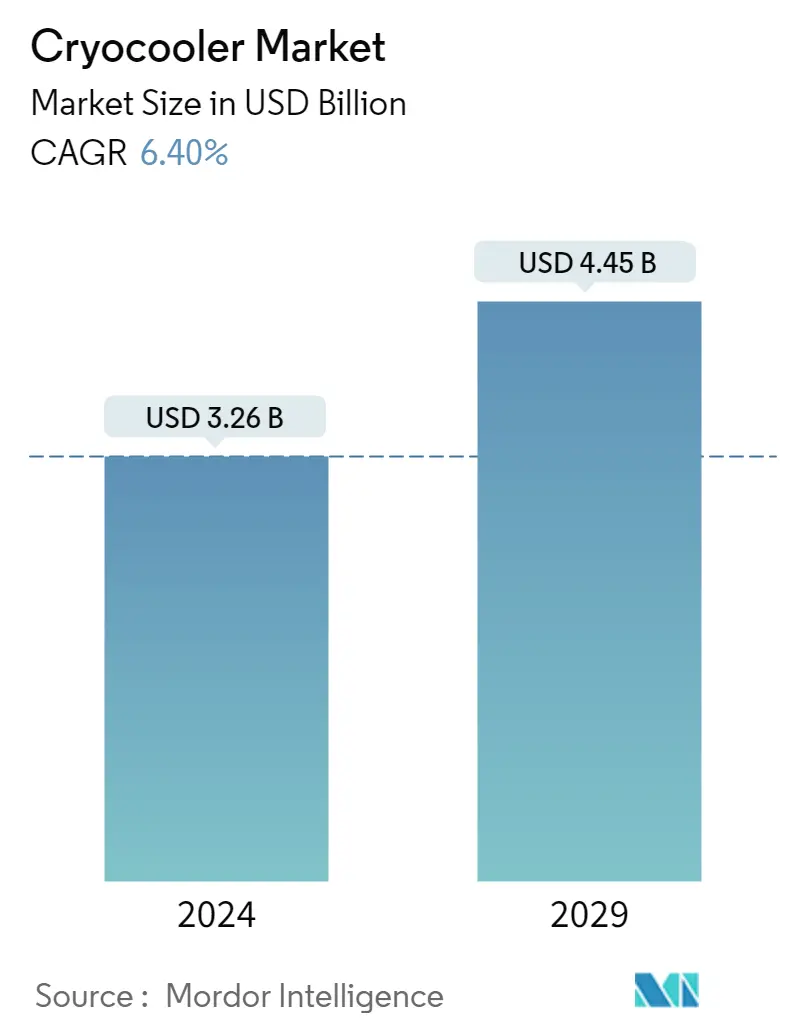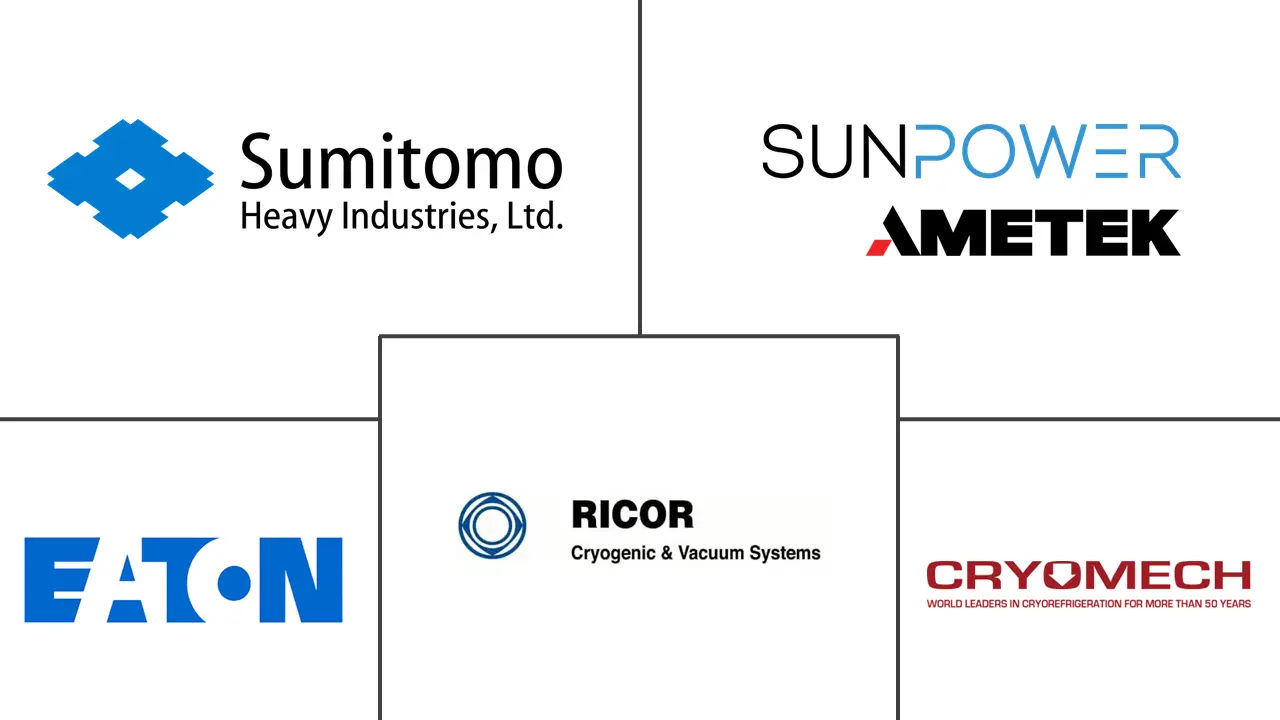Market Size of Cryocooler Industry

| Study Period | 2019 - 2029 |
| Market Size (2024) | USD 3.26 Billion |
| Market Size (2029) | USD 4.45 Billion |
| CAGR (2024 - 2029) | 6.40 % |
| Fastest Growing Market | Asia Pacific |
| Largest Market | North America |
Major Players
*Disclaimer: Major Players sorted in no particular order |
Cryocooler Market Analysis
The Cryocooler Market size is estimated at USD 3.26 billion in 2024, and is expected to reach USD 4.45 billion by 2029, growing at a CAGR of 6.40% during the forecast period (2024-2029).
- Technological development of cryocooler technology significantly expanded the use of these devices, as they can extend from a hospital magnetic resonance imaging (MRI) machine to military night vision devices to even longwave instruments on a space telescope.
- Some of the major factors driving the adoption of cryocoolers included the growing adoption across the military and defense sectors to maintain cryogenic temperatures for IR sensors installed in night-vision-based systems. The use of night vision devices has significantly increased in the last few years as countries advance their defense capabilities. Moreover, countries are increasing their military spending to adopt new technologies. As per SIPRI, in 2022, the United States spent around USD 876.94 billion on its military.
- Further, cryocoolers are used extensively in defense applications, mainly for the cooling of infrared focal planes. Quite specifically, cryocoolers are typically used to cool intrinsic semiconductor-type focal planes for mid-wave infrared (nominally 3-5-micron wavelength) and longwave infrared (nominally 9-12 micron) sensors.
- A significant number of improvements to cryocoolers have occurred in the past two decades, which, in turn, have allowed many more applications of cryogenics to flourish and find their way into the marketplace.
- Cooling of infrared and visible cameras continues to provide opportunities for small cryocoolers. While recent years have witnessed a shift from cooled to uncooled IR cameras, a market remains for high-performance infrared imagers cooled by small Stirling cycle cryocoolers.
- Developing spacecraft thermal management systems that depend on predictable cryocooler performance is one of the most challenging aspects of space thermal system design. Most of the developers rely on very sparse cryocooler performance data when conducting their system-level trade-offs.
Cryocooler Industry Segmentation
A cryocooler is a device that provides active cooling at cryogenic temperatures. As per the Cryogenic Society of America, Inc., a cryogenic cooler, or cryocooler, is designed to allow active cooling at temperatures of about -150 degrees Celsius. They use the flow of gas inside closed tubes, which absorbs the temperature and radiates it outside. The device generally uses helium or a mixture of gases.
The cryocooler market is segmented by end-user vertical (space, healthcare, military, commercial, transportation, and other end-user verticals) and geography (North America, Europe, Asia Pacific, and Rest of the World). The market sizes and forecasts are provided in terms of value in USD for all the segments.
| By End-user Vertical | |
| Space | |
| Healthcare | |
| Military | |
| Commercial | |
| Transportation | |
| Other End-user Verticals |
| By Geography | |
| North America | |
| Europe | |
| Asia Pacific | |
| Rest of the World |
Cryocooler Market Size Summary
The cryocooler market is poised for significant growth, driven by advancements in technology that have broadened the application scope of these devices across various sectors. Cryocoolers are increasingly utilized in military and defense for cooling infrared sensors in night vision systems, as countries enhance their defense capabilities. The healthcare sector also sees a rising demand for cryocoolers, particularly in MRI systems, cryosurgery, and proton therapy, where they are essential for maintaining superconducting magnets at low temperatures. Despite challenges such as high input power consumption, the benefits and technological advancements in cryocoolers continue to foster their adoption in medical applications. Additionally, cryocoolers play a crucial role in cryopreservation processes, which are vital in fields like reproductive medicine and cancer treatment, further propelling market growth.
North America is a key region driving the cryocooler market, with substantial investments in military and healthcare sectors. The United States leads in military spending, which supports the demand for cryocoolers in defense applications. In healthcare, the region's focus on developing new cancer treatments and technologies like proton therapy contributes to market expansion. The cryocooler market is moderately fragmented, with major players such as Sumitomo and Barry Automation Inc. employing strategies like product innovation and strategic partnerships to maintain competitiveness. Recent developments, such as Cryomech Inc.'s introduction of advanced cryocooler models and strategic acquisitions, highlight the dynamic nature of the market. Collaborations in sectors like hydrogen technology and space propulsion further underscore the diverse applications and growth potential of cryocoolers.
Cryocooler Market Size - Table of Contents
-
1. MARKET INSIGHTS
-
1.1 Market Overview
-
1.2 Industry Attractiveness - Porter's Five Forces Analysis
-
1.2.1 Bargaining Power of Suppliers
-
1.2.2 Bargaining Power of Buyers
-
1.2.3 Threat of New Entrants
-
1.2.4 Threat of Substitute Products and Services
-
1.2.5 Intensity of Competitive Rivalry
-
-
1.3 Industry Value Chain Analysis
-
1.4 Technology Snapshot
-
1.5 Impact of COVID-19 on the Market
-
-
2. MARKET SEGMENTATION
-
2.1 By End-user Vertical
-
2.1.1 Space
-
2.1.2 Healthcare
-
2.1.3 Military
-
2.1.4 Commercial
-
2.1.5 Transportation
-
2.1.6 Other End-user Verticals
-
-
2.2 By Geography
-
2.2.1 North America
-
2.2.2 Europe
-
2.2.3 Asia Pacific
-
2.2.4 Rest of the World
-
-
Cryocooler Market Size FAQs
How big is the Cryocooler Market?
The Cryocooler Market size is expected to reach USD 3.26 billion in 2024 and grow at a CAGR of 6.40% to reach USD 4.45 billion by 2029.
What is the current Cryocooler Market size?
In 2024, the Cryocooler Market size is expected to reach USD 3.26 billion.

